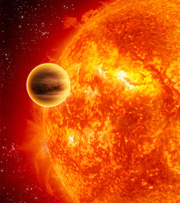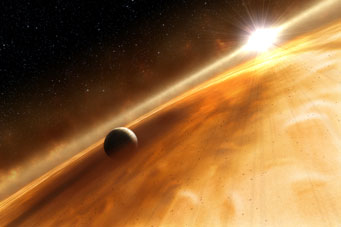Here's your chance to name an exoplanet, in a process recognized and officiated by the International Astronomical Union. Register your astronomy club or organization by June 1st!

C. Carreau / ESA
Astronomers have discovered thousands of exoplanets, but their names, such as HD104985 b, are often in an unfriendly telephone number format. Others, such as 51 Pegasi b, are slightly better, but still not appealing to the general public, nor enticing to the imagination.
For millennia, every civilization across the globe has given names to stars. In ancient days, only those stars that could be seen by the naked eye were named, but after the invention of telescope, the number of known stars increased exponentially. Astronomers developed schemes to catalog them and provide a scientific destination. Take 55 Cancri, the 55th star in the constellation Cancer (the Crab), ordered from west to east using the Flamsteed designation. Using the simpler Bayer designation gives another star the name Epsilon Eridani, because it’s the 5th brightest star (and epsilon is the 5th letter in the Greek alphabet) in the constellation Eridanus (the River).
The International Astronomical Union (IAU) was founded in 1919, and since then has served as the internationally recognized authority for assigning names to celestial bodies such as planets, comets, asteroids. For a long time, those decisions rested on the objects’ discoverers and on the IAU nomenclature committees.
Historically, IAU has not dealt with common names, only with official designations. But now, in response to the public’s increased interest in being part of astronomical discoveries, the IAU is organizing a worldwide contest: “NameExoWorlds” will give popular names to 20 exoplanet systems, including 32 exoplanets along with their host stars.
Here are the 20 systems up for naming:
| Host Star (catalog name) | Planet designation | Planet Mass (Jupiter masses) | Planet Mass (Earth masses) | Period (days) | Semi-major Axis (a.u.) | Discovery (year) | Constellation (Greek) | Host star visible mag. |
| 1 exoplanet (5 systems) | ||||||||
| Ain (epsilon Tauri) | epsilon Tauri b | 7.6 | 2415.5 | 594.9 | 1.93 | 2007 | Taurus | 3.5 |
| Edasich (iota Draconis) | iota Draconis b | 8.82 | 2803.3 | 510.7 | 1.275 | 2002 | Draco | 3.3 |
| Errai (gamma Cephei) | gamma Cephei b | 1.85 | 588 | 903.3 | 2.05 | 2003 | Cepheus | 3.2 |
| Fomalhaut (alpha Piscis Austrini) | Fomalhaut b | 3 | 953.5 | 320000 | 115 | 2008 | Piscis Austrinus | 1.2 |
| Pollux (beta Geminorum) | beta Geminorum b | 2.9 | 921.7 | 589.64 | 1.69 | 2006 | Gemini | 1.2 |
| 1 star + 1 exoplanet (10 systems) | ||||||||
| 14 Andromedae | 14 Andromedae b | 5.33 | 1694 | 185.84 | 0.83 | 2008 | Andromeda | 5.2 |
| 18 Delphinis | 18 Delphinis b | 10.3 | 3273.6 | 993.3 | 2.6 | 2008 | Delphinus | 5.5 |
| 42 Draconis | 42 Draconis b | 3.88 | 1233.2 | 479.1 | 1.19 | 2008 | Draco | 4.8 |
| 51 Pegasi | 51 Pegasi b | 0.47 | 148.7 | 4.23 | 0.052 | 1995 | Pegasus | 5.5 |
| epsilon Eridani | epsilon Eridani b | 1.55 | 492.6 | 2502 | 3.39 | 2000 | Eridanus | 3.7 |
| HD 104985 | HD 104985 b | 6.3 | 2002.3 | 198.2 | 0.78 | 2003 | Camelopardalis | 5.8 |
| HD 149026 | HD 149026 b | 0.36 | 113.1 | 2.88 | 0.04288 | 2005 | Hercules | 8.2 |
| HD 81688 | HD 81688 b | 2.7 | 858.1 | 184.02 | 0.81 | 2008 | Ursa Major | 5.4 |
| tau Bootis | tau Bootis b | 5.9 | 1875.2 | 3.31 | 0.046 | 1996 | Boötes | 4.5 |
| xi Aquilae | xi Aquilae b | 2.8 | 889.9 | 136.75 | 0.68 | 2008 | Aquila | 4.7 |
| 1 star + 2 exoplanets (1 system) | ||||||||
| 47 Ursae Majoris | 47 Ursae Majoris b | 2.53 | 804.1 | 1078 | 2.1 | 1996 | Ursa Major | 5.1 |
| 47 Ursae Majoris c | 0.54 | 171.6 | 2391 | 3.6 | 2001 | Ursa Major | 5.1 | |
| 1 star + 3 exoplanets (2 systems) | ||||||||
| PSR 1257+12 | PSR 1257+12 b | 7.00E-05 | 0.022 | 25.26 | 0.19 | 1992 | Virgo | - |
| PSR 1257+12 c | 0.01 | 4.1 | 66.54 | 0.36 | 1992 | Virgo | - | |
| PSR 1257+12 d | 0.01 | 3.8 | 98.21 | 0.46 | 1992 | Virgo | - | |
| upsilon Andromedae | upsilon Andromedae b | 0.62 | 197.1 | 4.62 | 0.059 | 1996 | Andromeda | 4.1 |
| upsilon Andromedae c | 1.8 | 572.1 | 237.7 | 0.861 | 1999 | Andromeda | 4.1 | |
| upsilon Andromedae d | 10.19 | 3238.7 | 1302.61 | 2.55 | 1999 | Andromeda | 4.1 | |
| 1 star + 4 exoplanets (1 system) | ||||||||
| mu Arae | mu Arae b | 1.68 | 532.7 | 643.25 | 1.5 | 2000 | Ara | 5.2 |
| mu Arae c | 0.03 | 10.6 | 9.64 | 0.09094 | 2004 | Ara | 5.2 | |
| mu Arae d | 0.52 | 165.9 | 310.55 | 0.921 | 2004 | Ara | 5.2 | |
| mu Arae e | 1.81 | 576.5 | 4205.8 | 5.235 | 2006 | Ara | 5.2 | |
| 1 star + 5 exoplanets (1 system) | ||||||||
| 55 Cancri | 55 Cancri b | 0.8 | 254.3 | 14.65 | 0.1134 | 1996 | Cancer | 6 |
| 55 Cancri c | 0.17 | 53.7 | 44.34 | 0.2403 | 2002 | Cancer | 6 | |
| 55 Cancri d | 3.84 | 1218.9 | 5218 | 5.76 | 2002 | Cancer | 6 | |
| 55 Cancri e | 0.03 | 8.3 | 0.74 | 0.0170 | 2004 | Cancer | 6 | |
| 55 Cancri f | 0.14 | 45.8 | 260.7 | 0.781 | 2007 | Cancer | 6 | |
Registered organizations voted for these 20 systems during an earlier stage of the IAU contest. They are a diverse set of systems, many of them significant in the history of exoplanet research. The list includes the first exoplanet ever discovered, orbiting the pulsar PSR 1257+12, the first exoplanet discovered around a normal star, 51 Pegasi b, and the five-exoplanet system 55 Cancri.

ESA / NASA / L. Calcada
Other systems tell fascinating stories: the planets of Upsilon Andromedae orbit on different planes, suggesting a possible past encounter with a rogue planet later ejected from the system. Another planet, Fomalhaut b, was imaged at visible wavelengths (a difficult feat) orbiting at the edge of the star’s dusty debris disk.
To submit names, you’ll have to go through an organization registered on the IAU Directory of World Astronomy website. Each registered organization can submit one naming proposal. To qualify, organizations must be non-profit and have organized one astronomy-related activity, a broad definition that enables schools to register too.
If your local astronomy club or other organization is interested in registering, the deadline isn’t over yet. Organizations can register with the IAU until June 1st. This is a golden opportunity to educate the general public on the science of exoplanets as well as the history and culture behind these astronomical discoveries.
Name submissions should follow IAU guidelines — for example, you can’t name a planet after your pet or any living person. As part of your submission, you’ll include a description to justify your proposal.
All of the submitted names will be open for a massive public voting to decide on the final names. The key to success rests on proposing names for the planets that can garner worldwide support.
The deadline for organizations to register with IAU for name submissions is 8 p.m. (EDT) on June 1st. Names themselves can be submitted until 8 p.m. (EDT) on June 15th. Check out the Name Exoworlds website for more details.
Sze-leung Cheung is the IAU International Outreach Coordiantor and heads the IAU Office for Astronomy Outreach, a global office for coordinating worldwide astronomy outreach activities. He was one of the key people behind the NameExoWorlds campaign.
 1
1
Comments
Boom2DaStars
May 1, 2015 at 2:13 pm
Just make sure something significant is called SAGAN and SPOCK.
You must be logged in to post a comment.
You must be logged in to post a comment.